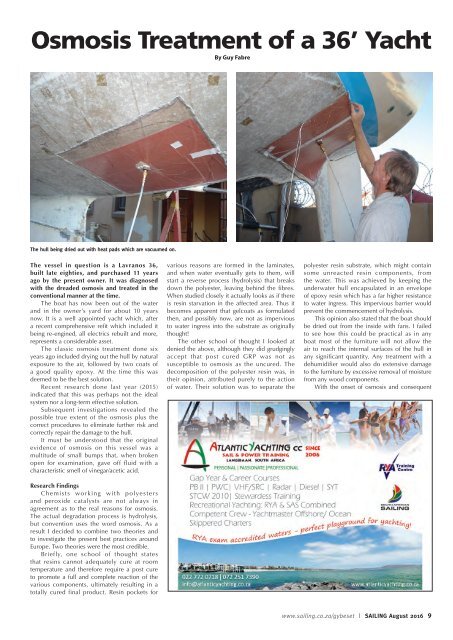You also want an ePaper? Increase the reach of your titles
YUMPU automatically turns print PDFs into web optimized ePapers that Google loves.
Osmosis Treatment of a 36’ Yacht<br />
By Guy Fabre<br />
The hull being dried out with heat pads which are vacuumed on.<br />
The vessel in question is a Lavranos 36,<br />
built late eighties, and purchased 11 years<br />
ago by the present owner. It was diagnosed<br />
with the dreaded osmosis and treated in the<br />
conventional manner at the time.<br />
The boat has now been out of the water<br />
and in the owner’s yard for about 10 years<br />
now. It is a well appointed yacht which, after<br />
a recent comprehensive refit which included it<br />
being re-engined, all electrics rebuilt and more,<br />
represents a considerable asset.<br />
The classic osmosis treatment done six<br />
years ago included drying out the hull by natural<br />
exposure <strong>to</strong> the air, followed by two coats of<br />
a good quality epoxy. At the time this was<br />
deemed <strong>to</strong> be the best solution.<br />
Recent research done last year (2015)<br />
indicated that this was perhaps not the ideal<br />
system nor a long-term effective solution.<br />
Subsequent investigations revealed the<br />
possible true extent of the osmosis plus the<br />
correct procedures <strong>to</strong> eliminate further risk and<br />
correctly repair the damage <strong>to</strong> the hull.<br />
It must be unders<strong>to</strong>od that the original<br />
evidence of osmosis on this vessel was a<br />
multitude of small bumps that, when broken<br />
open for examination, gave off fluid with a<br />
characteristic smell of vinegar/acetic acid.<br />
Research Findings<br />
Chemists working with polyesters<br />
and peroxide catalysts are not always in<br />
agreement as <strong>to</strong> the real reasons for osmosis.<br />
The actual degradation process is hydrolysis,<br />
but convention uses the word osmosis. As a<br />
result I decided <strong>to</strong> combine two theories and<br />
<strong>to</strong> investigate the present best practices around<br />
Europe. Two theories were the most credible.<br />
Briefly, one school of thought states<br />
that resins cannot adequately cure at room<br />
temperature and therefore require a post cure<br />
<strong>to</strong> promote a full and complete reaction of the<br />
various components, ultimately resulting in a<br />
<strong>to</strong>tally cured final product. Resin pockets for<br />
various reasons are formed in the laminates,<br />
and when water eventually gets <strong>to</strong> them, will<br />
start a reverse process (hydrolysis) that breaks<br />
down the polyester, leaving behind the fibres.<br />
When studied closely it actually looks as if there<br />
is resin starvation in the affected area. Thus it<br />
becomes apparent that gelcoats as formulated<br />
then, and possibly now, are not as impervious<br />
<strong>to</strong> water ingress in<strong>to</strong> the substrate as originally<br />
thought!<br />
The other school of thought I looked at<br />
denied the above, although they did grudgingly<br />
accept that post cured GRP was not as<br />
susceptible <strong>to</strong> osmosis as the uncured. The<br />
decomposition of the polyester resin was, in<br />
their opinion, attributed purely <strong>to</strong> the action<br />
of water. Their solution was <strong>to</strong> separate the<br />
polyester resin substrate, which might contain<br />
some unreacted resin components, from<br />
the water. This was achieved by keeping the<br />
underwater hull encapsulated in an envelope<br />
of epoxy resin which has a far higher resistance<br />
<strong>to</strong> water ingress. This impervious barrier would<br />
prevent the commencement of hydrolysis.<br />
This opinion also stated that the boat should<br />
be dried out from the inside with fans. I failed<br />
<strong>to</strong> see how this could be practical as in any<br />
boat most of the furniture will not allow the<br />
air <strong>to</strong> reach the internal surfaces of the hull in<br />
any significant quantity. Any treatment with a<br />
dehumidifier would also do extensive damage<br />
<strong>to</strong> the furniture by excessive removal of moisture<br />
from any wood components.<br />
With the onset of osmosis and consequent<br />
www.sailing.co.za/gybeset | <strong>SAILING</strong> <strong>August</strong> <strong>2016</strong> 9


